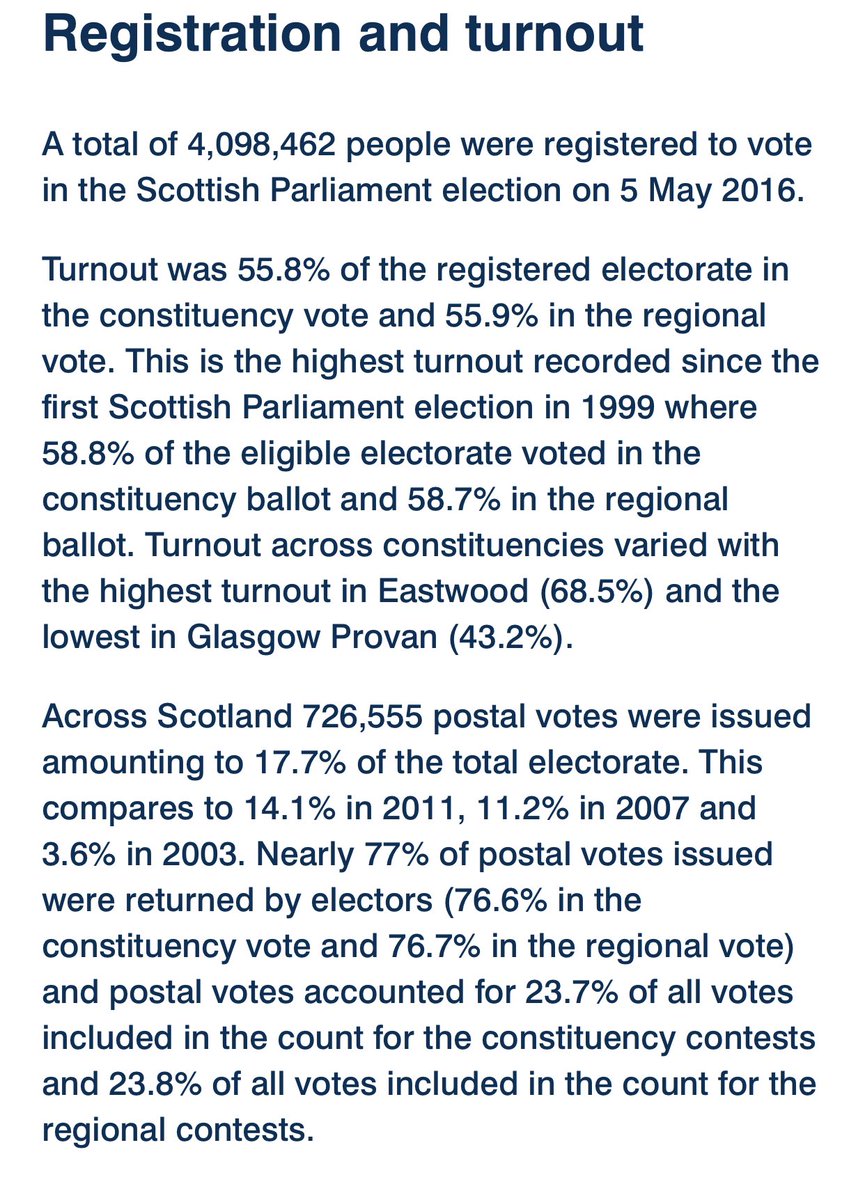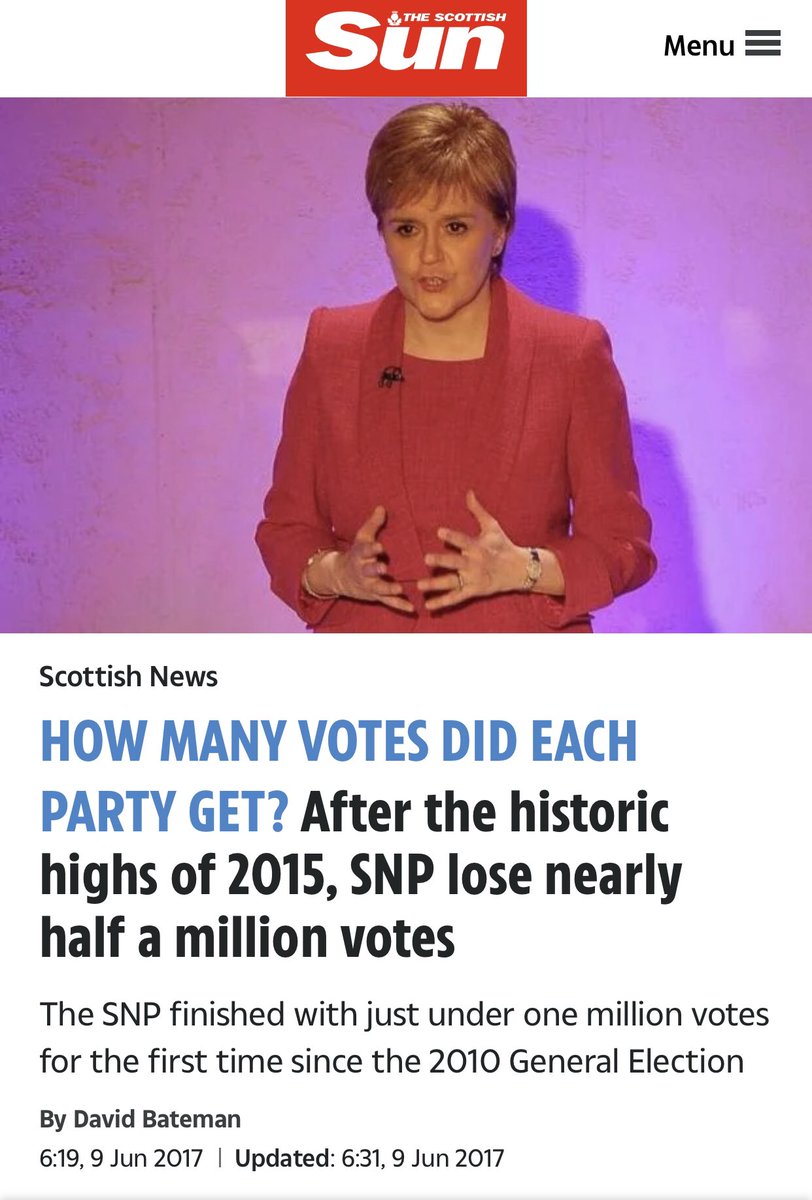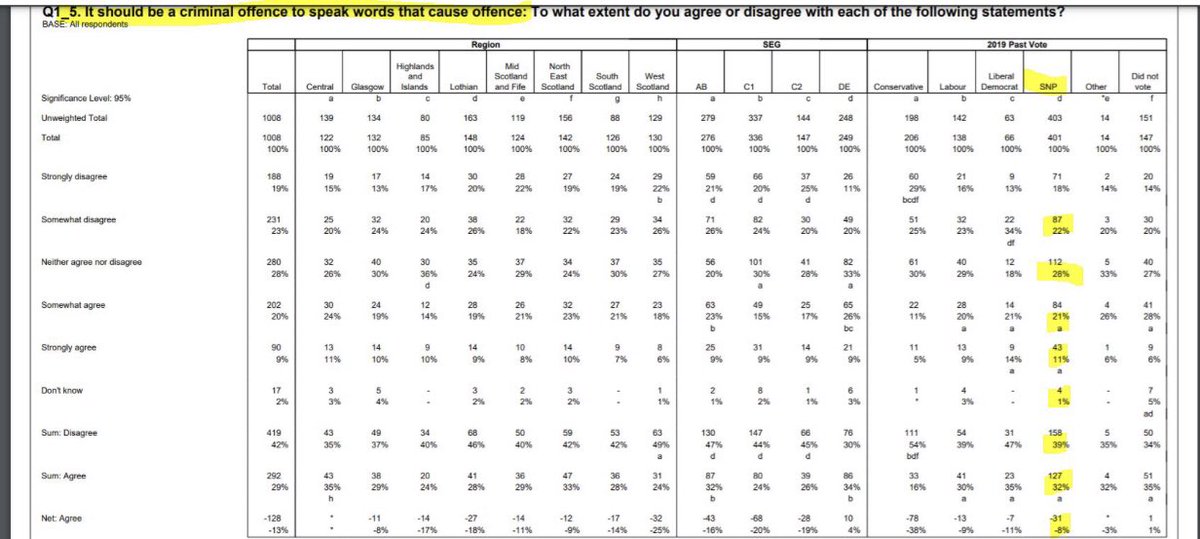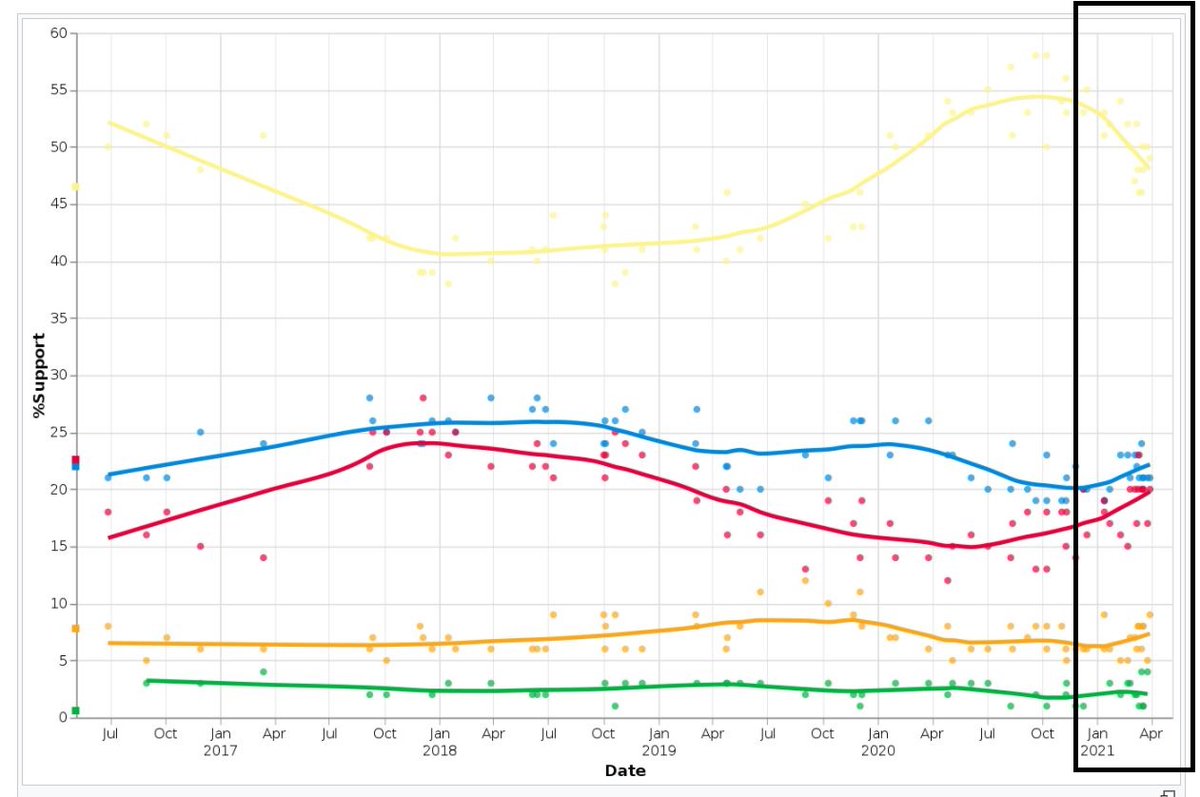
Why turnout & the number of postal votes matter in this election. And why Nicola Sturgeon is so risk averse as to duck BBCQT & unveil a magic money tree manifesto expanding middle class welfare
A thread.
(1/25)
A thread.
(1/25)
1️⃣ Postal Voting
The Holyrood 2021 election there are a million postal votes, 23.8% of the electorate.
This is an increase on the 17.7% in 2016.
(2/25)
The Holyrood 2021 election there are a million postal votes, 23.8% of the electorate.
This is an increase on the 17.7% in 2016.
(2/25)
In 2016 the election turnout overall was 55.8% (constituency) and 55.9% (regional)
And exactly 726,555 postal votes were issued (17.7% of the total electorate)
Almost 77% of postal votes issued were returned by electors in 2016
(3/25)
And exactly 726,555 postal votes were issued (17.7% of the total electorate)
Almost 77% of postal votes issued were returned by electors in 2016
(3/25)

So last time over three quarters of postal voters were cast.
On a turnout of 56% (rounded up)
(4/25)
On a turnout of 56% (rounded up)
(4/25)
This all matters because:
Assuming the same rate of postal votes issued being returned this election as last time then about ONE THIRD of all votes cast would be arriving by mail.
(5/25)
Assuming the same rate of postal votes issued being returned this election as last time then about ONE THIRD of all votes cast would be arriving by mail.
(5/25)
❓Who would benefit the most❓
➡️ I presume SNP. They have 100,000 odd members (maybe). So they would have a political machine rearing to go.
➡️ Also the Scottish Tories, as they are well versed in mobilising their voters
(6/25)
➡️ I presume SNP. They have 100,000 odd members (maybe). So they would have a political machine rearing to go.
➡️ Also the Scottish Tories, as they are well versed in mobilising their voters
(6/25)
Note: I’m speculating on who might benefit from the postal votes this time round, I am not Mystic Meg!
(7/25)
(7/25)
2️⃣ Turnout
Let’s begin by remembering the 2017 General Election.
That story is one where the SNP lost half a million votes.
But they didn’t necessarily lose all or even most of these votes to opposition parties.
(8/25)
Let’s begin by remembering the 2017 General Election.
That story is one where the SNP lost half a million votes.
But they didn’t necessarily lose all or even most of these votes to opposition parties.
(8/25)

One of the biggest reasons for the SNP haemorrhaging 13.1% of their vote share (dropping to just 36.9%) were previously identified SNP voters simply staying at home.
(9/25)
(9/25)
In short, the SNP in 2017 were battered by low turnout among their voters, or voters previously identified as theirs. These folk generally stayed at home.
Result: SNP lost a third of their seats. Going from 56 to 35.
(10/25)
Result: SNP lost a third of their seats. Going from 56 to 35.
(10/25)
So, in this election turnout really matters.
And the SNP have good reason to worry about a 2017 scenario:
Panel base poll (April 9-12) reveals that despite the headline 47% SNP share in the constituency, among those voters certain to vote, they drop to just 42%.
(11/25)
And the SNP have good reason to worry about a 2017 scenario:
Panel base poll (April 9-12) reveals that despite the headline 47% SNP share in the constituency, among those voters certain to vote, they drop to just 42%.
(11/25)

Presumably this is why we’re seeing:
➡️ Sturgeon making a big fanfare of lockdown easing (although we still won’t be able to drink inside a pub)
(12/25)
➡️ Sturgeon making a big fanfare of lockdown easing (although we still won’t be able to drink inside a pub)
(12/25)
➡️ Being risk averse: refusing to attend BBC QT, despite all other party leaders are (though this might backfire given who fronting for the SNP...)
(13/25)
(13/25)
➡️ Her quietened down television debate performances: she doesn’t want to scare any horses. Steady as she goes, don’t make much noise and so don’t risk rocking the boat.
(14/25)
(14/25)
➡️ magic money-tree manifesto: promises promises promises of free free free! Platitudes galore & pledges to expand on welfare to middle classes. Give SNP identified voters a reason to turnout (even if many are pissed off over GRA reform proposals or Hate Crime Bill*)
(15/25)
(15/25)
*and more SNP identified voters DO dislike core elements of the SNP’s Hate Crime Bill then like it. So Sturgeon is correct to worry it might depress her turnout.
Take a look at Comres polling...
(16/25)
Take a look at Comres polling...
(16/25)
'It should be a criminal offence to speak words that cause offence'
2019 SNP voters:
Strongly disagree - 18%
Somewhat disagree - 22%
Neither- 28%
Somewhat agree - 21%
Strongly agree - 11%
(17/25)
2019 SNP voters:
Strongly disagree - 18%
Somewhat disagree - 22%
Neither- 28%
Somewhat agree - 21%
Strongly agree - 11%
(17/25)

What at means is that more SNP voters disagree than agree with the core concept of the Hate Crime & Public Order Bill:
Sum disagree 39%
Sum agree 32%
Net: -8%
Thus Sturgeon is trying to compensate for this by over-promising on other shiny baubles in her manifesto...
(18/25)
Sum disagree 39%
Sum agree 32%
Net: -8%
Thus Sturgeon is trying to compensate for this by over-promising on other shiny baubles in her manifesto...
(18/25)
She is so worried about SNP turnout she also deliberately postponed her GRA reforms, knowing they’d be unpopular. So she quietly punted them until after the election.
(19/25)
(19/25)

3️⃣ Conclusions:
➡️ Anas Sarwar is more popular than his party, this is Scottish Labour’s big advantage. But they need to bank on on-day voting ... big worry
➡️ There will be a substantially greater number of postal-ballots making up the final tally this election
(20/25)
➡️ Anas Sarwar is more popular than his party, this is Scottish Labour’s big advantage. But they need to bank on on-day voting ... big worry
➡️ There will be a substantially greater number of postal-ballots making up the final tally this election
(20/25)
➡️ High number of postal votes could benefit SNP and Scottish Tory
➡️ But SNP do have reasons to be concerned about their on-day turnout. Their headline % share in polling conceals a much lower % share in same polls among those certain to vote
(21/25)
➡️ But SNP do have reasons to be concerned about their on-day turnout. Their headline % share in polling conceals a much lower % share in same polls among those certain to vote
(21/25)
➡️ SNP divisions on Hate Crime legislation and GRA reform proposals are real, and risk depressing SNP turnout.
(22/25)
(22/25)
Sources:
Electoral Commission Report on how 2016 election was run:
electoralcommission.org.uk/who-we-are-and…
BBC: ‘General election 2017: SNP lose a third of seats amid Tory surge’
bbc.co.uk/news/uk-scotla…
Scottish Sun: ‘SNP lose nearly half a million votes’
thescottishsun.co.uk/news/scottish-…
(23/25)
Electoral Commission Report on how 2016 election was run:
electoralcommission.org.uk/who-we-are-and…
BBC: ‘General election 2017: SNP lose a third of seats amid Tory surge’
bbc.co.uk/news/uk-scotla…
Scottish Sun: ‘SNP lose nearly half a million votes’
thescottishsun.co.uk/news/scottish-…
(23/25)
Panelbase April Poll data table:
drg.global/wp-content/upl…
Times: ‘Who will win the 2021 Scottish elections? Our predictions and polls’
thetimes.co.uk/article/5aee28…
Savanta Comres Free Speech poll:
comresglobal.com/polls/free-to-…
(24/25)
drg.global/wp-content/upl…
Times: ‘Who will win the 2021 Scottish elections? Our predictions and polls’
thetimes.co.uk/article/5aee28…
Savanta Comres Free Speech poll:
comresglobal.com/polls/free-to-…
(24/25)
How a new Hate Crime Bill reveals the SNP’s unmoored approach to governance
newstatesman.com/politics/uk/20…
(25/25)
newstatesman.com/politics/uk/20…
(25/25)
This link will (I hope!) take you to a collection of my previous twitter threads.
threadreaderapp.com/user/DeanMThom…
threadreaderapp.com/user/DeanMThom…
• • •
Missing some Tweet in this thread? You can try to
force a refresh










